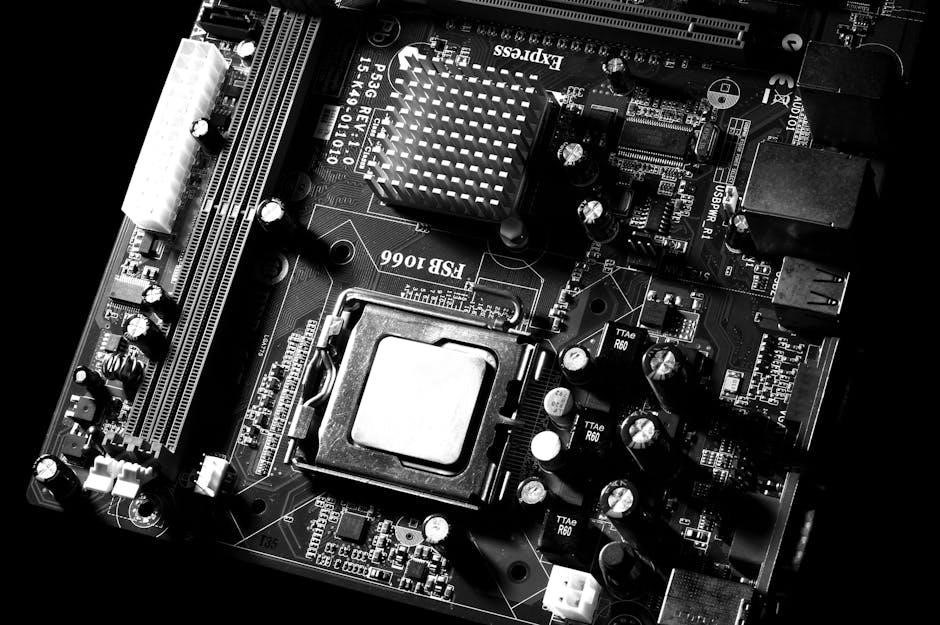locomotor system pdf
Overview of the Locomotor System
The locomotor system, comprising bones, muscles, joints, and nerves, enables movement and provides structural support. It is essential for mobility, protection, and maintaining body posture.
1.1 Definition and Importance
The locomotor system, also known as the musculoskeletal system, is a complex framework that enables movement and provides structural support to the body. It is composed of bones, joints, muscles, and peripheral nerves, working in harmony to facilitate various forms of locomotion, such as walking, running, and climbing. This system is vital for maintaining posture, protecting internal organs, and allowing individuals to interact with their environment. Its importance extends to overall health, as dysfunction in the locomotor system can lead to disabilities and significantly impact quality of life. Understanding its structure and function is essential for diagnosing and managing disorders that affect mobility and independence.
1.2 Components of the Locomotor System
The locomotor system comprises four primary components: bones, joints, muscles, and peripheral nerves. Bones provide structural support and protection for internal organs, while joints act as points of connection, enabling flexibility and movement. Muscles, including skeletal, smooth, and cardiac types, generate force to facilitate motion through contraction. Peripheral nerves transmit signals from the central nervous system to muscles, coordinating movement and sensation. Together, these components work in harmony to enable locomotion, maintain posture, and protect vital organs. Their integrated function is essential for mobility, stability, and overall physical activity, making the locomotor system a fundamental aspect of human physiology and movement.

Components of the Locomotor System
The locomotor system consists of bones, muscles, joints, and nerves, functioning collectively to enable movement, provide structural support, and maintain posture and organ protection.
2.1 Bones and Joints
Bones provide structural support and protect internal organs, while joints enable movement by connecting bones. The axial skeleton includes skull, spine, and ribs, and the appendicular skeleton comprises limbs and pelvis. Joints vary in mobility, from immovable (cranial sutures) to highly mobile (shoulder, hip). Their integrity depends on ligaments and cartilage. Degeneration or injury can impair joint function, leading to conditions like arthritis. Proper alignment and health of bones and joints are crucial for effective movement and overall locomotor function. This subheading focuses solely on the anatomical and functional aspects of bones and joints without delving into related muscles or nerves.
2.2 Muscles and Their Functions
Muscles are essential for movement, providing the force needed for locomotion. There are three types: skeletal (voluntary), smooth (involuntary), and cardiac (heart-specific). Skeletal muscles, attached to bones via tendons, enable voluntary movements like walking and lifting. Smooth muscles control involuntary actions, such as digestion, while cardiac muscles sustain heart contractions. Muscles function through contraction and relaxation, regulated by the nervous system. Their coordination ensures precise movements, from fine motor tasks to large-scale locomotion. Weakness or atrophy in muscles can impair mobility, highlighting their critical role in the locomotor system. This section focuses solely on muscle anatomy and function, avoiding overlap with joint or nerve discussions.
2.3 Peripheral Nerves and Their Role
Peripheral nerves are crucial for transmitting motor and sensory signals between the central nervous system and the locomotor system. They regulate muscle contraction, enabling movement and coordination. Sensory nerves detect stimuli, such as pain or touch, while motor nerves execute voluntary actions. Damage to these nerves can lead to muscle weakness or paralysis, impairing mobility. Their role is solely to facilitate communication, ensuring precise control over locomotion and responses to environmental changes. This section examines the structure and functions of peripheral nerves within the locomotor system, avoiding discussion of related topics like joint mechanics or muscle composition.

Biomechanics and Movement Analysis
Biomechanics applies physics and engineering principles to study body movements, analyzing forces and their effects on locomotion. Movement analysis examines joint and muscle interactions during motion.
3.1 Principles of Biomechanics
Biomechanics employs principles from physics and engineering to analyze movement. Key concepts include force, torque, and motion, which influence how the body performs tasks like walking or lifting. Understanding these principles helps in assessing joint function and muscle mechanics, enabling better diagnosis of movement disorders. By applying biomechanical laws, healthcare professionals can evaluate the efficiency of locomotion and identify inefficiencies or pathologies. This knowledge is crucial for developing effective treatment plans and improving mobility in individuals with musculoskeletal conditions.

3.2 Analysis of Joint Movements
Joint movement analysis involves studying the range, pattern, and quality of motion within the locomotor system. It assesses how bones and joints interact to facilitate activities like walking or reaching. Key aspects include understanding the types of movements (e.g., flexion, extension, rotation) and the forces involved. Joint stability and mobility are evaluated to identify limitations or abnormalities. Techniques such as goniometry and visual observation are used to measure movement ranges. This analysis is vital for diagnosing conditions like arthritis or ligament injuries and for developing rehabilitation plans. It also helps in understanding how joint function impacts overall locomotion and daily activities. Accurate assessment ensures targeted interventions to restore or improve mobility. Joint movement analysis is a cornerstone in both clinical practice and sports medicine.

Disorders of the Locomotor System
The locomotor system is prone to inflammatory, degenerative, metabolic, and developmental disorders, often causing pain, swelling, and limited mobility, affecting joints, bones, and muscles.
4.1 Inflammatory Disorders
Inflammatory disorders of the locomotor system, such as arthritis, are characterized by pain, swelling, and stiffness in joints and surrounding tissues. These conditions often result from autoimmune responses, infections, or prolonged inflammation. Rheumatoid arthritis, for instance, causes symmetric joint involvement and morning stiffness, while osteoarthritis is associated with cartilage degradation. Inflammatory disorders can lead to limited mobility, joint deformities, and chronic pain, significantly impacting quality of life. Early diagnosis and treatment are crucial to manage symptoms and prevent long-term damage. Therapies may include anti-inflammatory medications, physical therapy, and lifestyle modifications. In severe cases, surgical interventions such as joint replacements may be necessary to restore function and alleviate discomfort;
4.2 Degenerative Disorders
Degenerative disorders of the locomotor system, such as osteoarthritis, result from the gradual wear and tear of joints and surrounding tissues. These conditions often stem from aging, obesity, or repetitive stress. Osteoarthritis, the most common degenerative disorder, involves cartilage breakdown, leading to pain, stiffness, and limited mobility. Symptoms typically worsen over time, with joint deformities and loss of function in severe cases. Degenerative disorders can also affect muscles and ligaments, causing instability and chronic discomfort. Treatment focuses on managing symptoms through physical therapy, pain relief medications, and lifestyle modifications. In advanced cases, surgical interventions like joint replacements may be necessary to restore mobility and alleviate pain. Early intervention is key to slowing disease progression and improving quality of life.
4.3 Metabolic and Developmental Disorders
Metabolic and developmental disorders of the locomotor system arise from abnormalities in tissue development or biochemical processes. Conditions like rickets and osteoporosis are caused by deficiencies in calcium or vitamin D, leading to weakened bones and increased fracture risk. Developmental disorders, such as congenital clubfoot or hip dysplasia, result from abnormal tissue formation during growth. These disorders often manifest early in life, causing deformities and functional limitations. Symptoms include pain, limited mobility, and visible malformations. Treatment typically involves corrective measures like braces, physical therapy, or surgery to restore alignment and function. Early diagnosis and intervention are crucial to improve outcomes and quality of life for individuals with these conditions. Addressing underlying metabolic imbalances is also essential to prevent further complications and promote overall musculoskeletal health.
Clinical Examination of the Locomotor System
The clinical examination of the locomotor system is a systematic process to identify abnormalities and assess functional disability. It involves history taking, inspection, palpation, movement assessment, muscle strength testing, and special tests to evaluate joint mobility and detect pathologies.
5;1 History Taking and Symptom Assessment
History taking is the cornerstone of locomotor system assessment. It involves gathering detailed information about symptoms, such as onset, duration, and severity of pain, stiffness, or swelling. Patients are asked about specific joints involved, types of pain (sharp or dull), and factors that exacerbate or relieve symptoms. A thorough medical history, including past injuries, chronic conditions, or developmental disorders, is essential. The clinician also inquires about functional limitations, such as difficulty walking or performing daily activities. This information helps identify potential causes, whether inflammatory, degenerative, or metabolic. Accurate symptom assessment ensures a focused physical examination and appropriate diagnostic tests.
5.2 Inspection and Palpation Techniques
Inspection involves visually examining the locomotor system to identify swelling, deformities, or asymmetries. The patient is observed in various positions to assess posture, alignment, and range of motion. Palpation uses manual techniques to detect tenderness, warmth, or abnormal textures in muscles, joints, and bones. These methods help localize pain and identify structural abnormalities. Careful inspection and palpation are essential for distinguishing between inflammatory, degenerative, or traumatic conditions. They provide immediate feedback, guiding further diagnostic steps like imaging or specialized tests. Proper technique ensures accuracy and patient comfort, making these methods fundamental in clinical practice for assessing musculoskeletal health.
5.3 Movement Assessment and Functional Tests
Movement assessment evaluates the locomotor system’s functionality through active and passive range of motion exercises. These tests identify limitations or irregularities in joint mobility and muscle flexibility. Functional tests simulate daily activities, such as squatting or walking, to gauge the patient’s ability to perform tasks. Specialized assessments, like gait analysis, detect abnormalities in movement patterns. These evaluations help determine the impact of disorders on mobility and guide rehabilitation planning. By focusing on real-world movements, they provide insights into the patient’s functional capacity and inform targeted interventions to restore normal locomotor function and improve quality of life. Accurate assessment ensures effective treatment strategies for various musculoskeletal conditions.
5.4 Muscle Strength Testing and Special Tests
Muscle strength testing evaluates the power and function of specific muscle groups, essential for diagnosing weakness or imbalances. Techniques include manual resistance and dynamometer measurements. Special tests, such as the Patrick’s test for hip assessment or the Phalen’s test for carpal tunnel syndrome, are used to identify specific pathologies. These tests assess joint stability, ligament integrity, and soft tissue conditions. They are critical for pinpointing abnormalities that may not be evident during routine examination. By combining strength testing with special maneuvers, clinicians can accurately diagnose conditions like tendinitis or ligament sprains. These assessments are vital for developing targeted rehabilitation plans and ensuring optimal recovery from musculoskeletal injuries or disorders. Regular use of these tests in clinical practice enhances diagnostic accuracy and treatment outcomes.